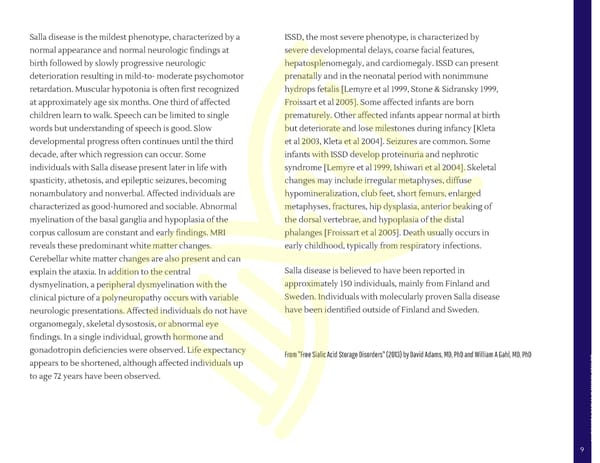Salla disease is the mildest phenotype, characterized by a ISSD, the most severe phenotype, is characterized by normal appearance and normal neurologic findings at severe developmental delays, coarse facial features, birth followed by slowly progressive neurologic hepatosplenomegaly, and cardiomegaly. ISSD can present deterioration resulting in mild-to- moderate psychomotor prenatally and in the neonatal period with nonimmune retardation. Muscular hypotonia is often first recognized hydrops fetalis [Lemyre et al 1999, Stone & Sidransky 1999, at approximately age six months. One third of affected Froissart et al 2005]. Some affected infants are born children learn to walk. Speech can be limited to single prematurely. Other affected infants appear normal at birth words but understanding of speech is good. Slow but deteriorate and lose milestones during infancy [Kleta developmental progress often continues until the third et al 2003, Kleta et al 2004]. Seizures are common. Some decade, after which regression can occur. Some infants with ISSD develop proteinuria and nephrotic individuals with Salla disease present later in life with syndrome [Lemyre et al 1999, Ishiwari et al 2004]. Skeletal spasticity, athetosis, and epileptic seizures, becoming changes may include irregular metaphyses, diffuse nonambulatory and nonverbal. Affected individuals are hypomineralization, club feet, short femurs, enlarged characterized as good-humored and sociable. Abnormal metaphyses, fractures, hip dysplasia, anterior beaking of myelination of the basal ganglia and hypoplasia of the the dorsal vertebrae, and hypoplasia of the distal corpus callosum are constant and early findings. MRI phalanges [Froissart et al 2005]. Death usually occurs in reveals these predominant white matter changes. early childhood, typically from respiratory infections. Cerebellar white matter changes are also present and can Salla disease is believed to have been reported in explain the ataxia. In addition to the central approximately 150 individuals, mainly from Finland and dysmyelination, a peripheral dysmyelination with the Sweden. Individuals with molecularly proven Salla disease clinical picture of a polyneuropathy occurs with variable have been identified outside of Finland and Sweden. neurologic presentations. Affected individuals do not have organomegaly, skeletal dysostosis, or abnormal eye findings. In a single individual, growth hormone and gonadotropin deficiencies were observed. Life expectancy Letter from STAR President From "Free Sialic Acid Storage Disorders" (2013) by David Adams, MD, PhD and William A Gahl, MD, PhD appears to be shortened, although affected individuals up to age 72 years have been observed. 9
 2018-2019 progress report Page 9 Page 11
2018-2019 progress report Page 9 Page 11